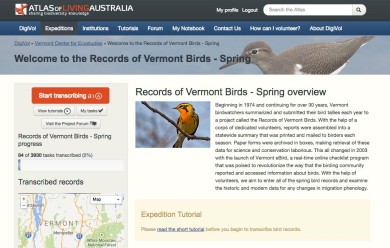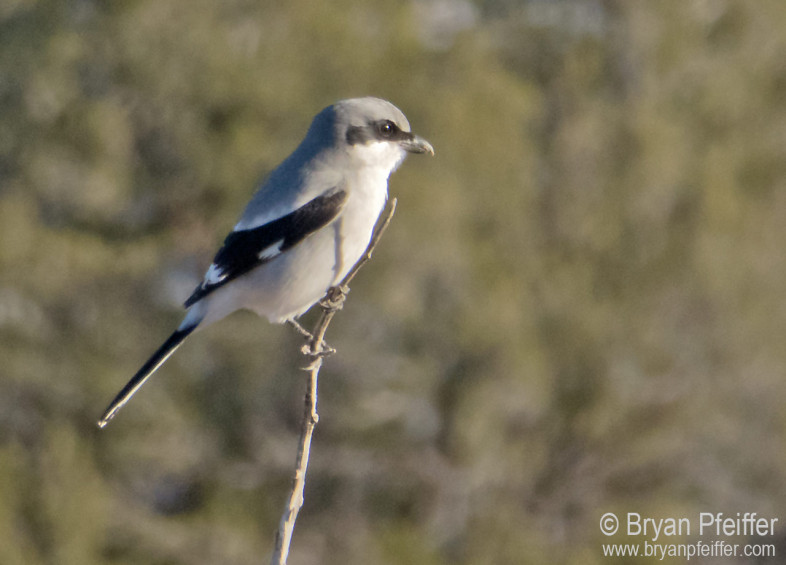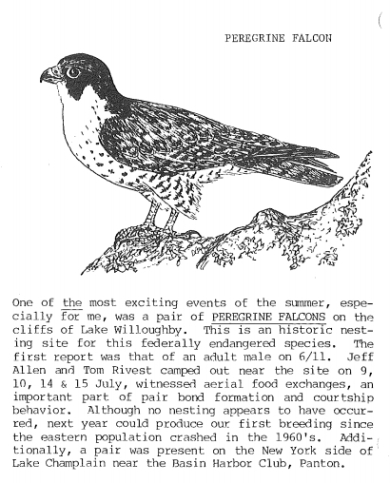THOSE WHO FORGET THE PAST are doomed … to forsake priceless data that can help us conserve wildlife. VCE today officially launches an ambitious project to retrieve historic bird sightings, some a century old, now trapped in notebooks, on scraps of paper and in dusty file drawers.
With help from a new breed of “citizen archeologists” and novel crowd-source technology, VCE plans to unearth and add these lost bird sightings to our vast, growing digital database so that they can be of use by birdwatchers, scientists, students and conservationists for generations.
“We sometimes forget that digital collection of bird data is really in its infancy,” says VCE conservation biologist Kent McFarland. “We’ve got a century of valuable sightings that preceded Vermont eBird and other data projects. So our policy now is, ‘No bird sighting left behind.’”
 VCE has informally named the initiative, which is part of the Vermont Atlas of Life, the “Phoenix Project,” for the mythical bird reborn from the ashes of its predecessor. But the rebirth of bird sightings data depends on a dedicated corps of volunteers who, in their leisure time and from the comfort of home, can easily move bird sightings from paper to computer.
VCE has informally named the initiative, which is part of the Vermont Atlas of Life, the “Phoenix Project,” for the mythical bird reborn from the ashes of its predecessor. But the rebirth of bird sightings data depends on a dedicated corps of volunteers who, in their leisure time and from the comfort of home, can easily move bird sightings from paper to computer.
To make it happen, VCE has traveled virtually around the world to team up with the Atlas of Living Australia (ALA), which in collaboration with the Australian Museum has developed DigiVol. DigiVol allows volunteers to view scans of the paper documents online, and convert them on the spot to digital form. From there, VCE will add the records to Vermont eBird for use free of charge to anyone — from students to birders to researchers.
“What’s inspiring is that VCE and our volunteers are joining a global effort to unearth a treasure of biodiversity data now locked up in field notebooks, old survey sheets and personal notes,” said McFarland. “Although many of the people who scribbled or typed those sightings onto paper are now gone, their data can live on and help us discover and conserve birds and other wildlife.”
A giant first step in the Phoenix Project will be to digitize bird sightings from a paper publication many of you may fondly remember: Records of Vermont Birds (RVB). For 30 years, RVB was the most complete and authoritative source of bird sightings, including first arrival dates for migrants, ever assembled — on paper. RVB’s publisher, the Vermont Institute of Natural Science, has given to VCE the treasure of historic bird records behind RVB. With your help, we will bring that data online.
We’ve already uploaded a decade of spring bird sightings data to Vermont eBird thanks to a core group of volunteers. JoAnne Russo and Sue Elliot each entered three years of records into a database. Steve Antell added two years of data and Josh Phillips added a season.
But many more years of historic data remain for us to enter. So three dedicated volunteers — Carla Skinder, Joan Hoffmann and Martha Nelson — have painstakingly scanned each spring report from the Record of Vermont Bird archives. That’s thousands of pages of scans. Each page has been uploaded to VCE’s home on the DigiVol system, and is now ready for crowd-sourced digitizing. In fact, volunteers in Australia who have found our scans are already digitizing it.
Here at VCE, we’re already putting some of the digitized data to use. Since much of those early bird sightings were first collected, the growing season in Vermont has increased by about two weeks. Ice-out on lakes and leaf-out on the lilacs in our front yards come about 12 days sooner. Although the phenology — or the timing of major natural events — varies normally from year to year, on average Vermont springs come earlier. And that could be a concern for bird conservation. As plants and insects emerge earlier in the season, for example, we can analyze whether birds have adequately adjusted the timing of their own migration or breeding cycles to keep pace. A mismatch could cause bird populations to decline.
Visit our DigiVol site where you can register and login. You’ll find a short tutorial to read before getting started. If you have questions or would like to share a neat observation you uncover during your travels through these historic records, there’s even a project forum to post notes to the community.
“By recruiting volunteers distributed around the world,” said McFarland, “many hands will make light work of conservation.”



I’d be glad to help again.
Please make sure Chris has info on entering old records when he comes WEST on May 18. I have mine as well as Dale Earl’s whom you probably never knew, but Chris did. She had the first state record of TUTI! No data such as is recorded today, however.
Ruth